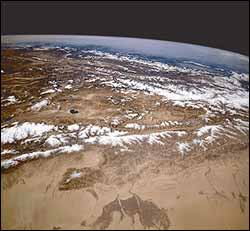Scientists determine fault near tsunami area moving 10 millimeters per year

This space shuttle photo looks south from the Tarim Basin in the foregound across the western Kunlun range and on to the Indian subcontinent in the distance. The two major faults of western Tibet, the Karakax and the Karakorum faults, are clearly seen as linear features cutting across the image. Photo: Earth Sciences and Image Analysis/NASA-Johnson Space Center
Livermore researchers have determined the Karakorum fault in Tibet, a feature formed by the same tectonic “collision” that caused the recent tsunami, has slipped 10 millimeters per year during the last 140,000 years.
Earlier research by outside scientists using satellite radar interferometry (InSAR) conducted over a decadal time scale indicated that the Karakorum fault and the Karakax segment of the Altyn Tagh fault in western Tibet are essentially inactive.
But Livermore scientists Rick Ryerson, Marie-Luce Chevalier (a visiting student from the Institut de Physique du Globe de Paris), and Bob Finkel, along with colleagues in France and China, studied Karakorum movement along a single strand of the fault system over a millennial time scale and found the slip to be 10 times larger than that of the slip rate across the entire fault from the InSAR data.
Karakorum is the main right-lateral motion fault north of the Himalayas and is in the same area as the earthquakes that caused the tsunami in Asia. Both areas are located on the northern edge of the Indian plate where northward motion has caused earthquakes and the growth of the Tibetan plateau.
“Determining the past and present movement along the Karakorum fault is crucial in understanding the movement of the entire Asian continent,” Ryerson said. “It’s the collision of the India continental material and the Asian continental material that has caused the uplift of the Himalayas and Tibet.”
The research appears in the Jan. 21 edition of the journal Science.
Livermore researchers measured the mid- to late-Pleistocene (from two million to 11,000 years ago) slip rate on the southern stretch of the fault by dating two moraine crests displaced by the fault at the end of the Manikala glacial valley. A moraine is an accumulation of boulders, stones or other debris carried and deposited by a glacier. The dating method is based upon the accumulation of isotopes produced when cosmic-rays hit the earth’s surface.
From dating the two moraines, they determined that they become younger from east to west, which is consistent with the right-lateral motion on the fault. “Ultimately this research should lead to the development of new models that accommodate and explain the different slip rates,” Ryerson said.
The researchers further concluded that the rate of movement between southwestern Tibet and the western Himalayas should be greater than 10 millimeters per year because movement on the main fault (Altyn Tagh) along with slip from other active faults in the region need to be taken into account.
Researchers from Laboratoire de Tectonique, Institut de Physique du Globe de Paris, Institut de Physique du Globe de Strasbourg, the Chinese Academy of Geological Sciences and Total Exploration China also contributed to the report.
Media Contact
More Information:
http://www.llnl.govAll latest news from the category: Earth Sciences
Earth Sciences (also referred to as Geosciences), which deals with basic issues surrounding our planet, plays a vital role in the area of energy and raw materials supply.
Earth Sciences comprises subjects such as geology, geography, geological informatics, paleontology, mineralogy, petrography, crystallography, geophysics, geodesy, glaciology, cartography, photogrammetry, meteorology and seismology, early-warning systems, earthquake research and polar research.
Newest articles

Why getting in touch with our ‘gerbil brain’ could help machines listen better
Macquarie University researchers have debunked a 75-year-old theory about how humans determine where sounds are coming from, and it could unlock the secret to creating a next generation of more…

Attosecond core-level spectroscopy reveals real-time molecular dynamics
Chemical reactions are complex mechanisms. Many different dynamical processes are involved, affecting both the electrons and the nucleus of the present atoms. Very often the strongly coupled electron and nuclear…

Free-forming organelles help plants adapt to climate change
Scientists uncover how plants “see” shades of light, temperature. Plants’ ability to sense light and temperature, and their ability to adapt to climate change, hinges on free-forming structures in their…





















